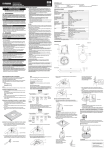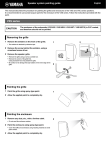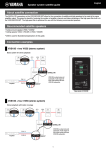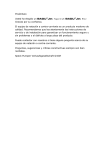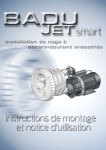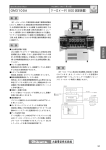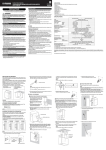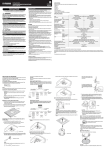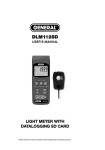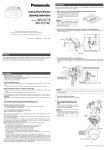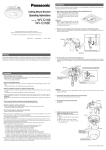Download Yamaha VXC4/VXC4W Owner's Manual
Transcript
EN Ceiling Speaker Owner’s Manual UNPACKING ZE19530 Unpack the contents and confirm that all the following items are included. English • Speaker × 2 • Screw × 4 • Grille × 2 • Cutout Template × 1 • O-ring × 2 • Owner’s Manual (this manual) • Tile Rail × 4 * Speaker cable and safety wire are not included. Handling caution PRECAUTIONS PLEASE READ CAREFULLY BEFORE PROCEEDING * Please keep this manual in a safe place for future reference. WARNING Always follow the basic precautions listed below to avoid the possibility of serious injury or even death from electrical shock, shortcircuiting, damages, fire or other hazards. These precautions include, but are not limited to, the following: Do not open • This device contains no user-serviceable parts. Do not open the device or attempt to disassemble the internal parts or modify them in any way. If it should appear to be malfunctioning, discontinue use immediately and have it inspected by qualified Yamaha service personnel. Water warning • Do not expose the device to rain, use it near water or in damp or wet conditions, or place on it any containers (such as vases, bottles or glasses) containing liquids which might spill into any openings. If any liquid such as water seeps into the device, have the device inspected by qualified Yamaha service personnel. SPECIFICATIONS • Do not insert your fingers or hands in any gaps or openings on the device (ports). • Avoid inserting or dropping foreign objects (paper, plastic, metal, etc.) into any gaps or openings on the device (ports). If this happens, have the device inspected by qualified Yamaha service personnel. • Do not operate the device if the sound is distorting. Prolonged use in this condition could cause overheating and result in fire. • When choosing a power amplifier for use with this device, make sure that the output power of the amplifier is lower than the power capacity of this device (see SPECIFICATIONS). Even if the output power of the amplifier is lower than the power capacity of this device (program), use of excessive input signals resulting in clipping may cause damage to the device. Malfunction or fire may occur especially when the following sounds or noises are generated: - feedback, when using a microphone - continuous and extreme volume sound from a musical instrument - extreme continuous distorted sound - noise caused by plugging/unplugging the cable while the amplifier is turned on Type Component Coverage Angle (500 Hz – 4 kHz on average) Nominal Impedance Power Rating NOISE (IEC, 100h) *1 PGM MAX Sensitivity (1W, 1m) *2 Maximum SPL (Calculated, 1m) *3 Frequency Range (-10 dB) *2 Connector Transformer Taps Overload Protection Magnetically Shielded Enclosure Grille NOTICE To avoid the possibility of malfunction/damage to the product, damage to data, or damage to other property, follow the notices below. CAUTION Always follow the basic precautions listed below to avoid the possibility of physical injury to you or others, or damage to the device or other property. These precautions include, but are not limited to, the following: Location • Do not place the device in an unstable position where it might accidentally fall over. • Do not place the device in a location where it may come into contact with corrosive gases or salt air. Doing so may result in malfunction. • Construction work should be carried out in accordance with constructionrelated law and always by a professional constructor. If the device installation requires construction work, make sure to observe the following precautions. - Choose mounting hardware and an installation location that can support the weight of the device. - Avoid locations that are exposed to constant vibration. - Use the required tools to install the device. - Inspect the device periodically. Connections • Before connecting the device to a power amplifier, turn off the power for all devices. Before turning the power on or off for all devices, set all volume levels to minimum. • Use only speaker cables for connecting speakers to the speaker jacks. Use of other types of cables may result in fire. Maintenance • Do not wipe the outer packaging with benzine, thinner, or synthetic detergent and do not use electrical contact cleaner. These may damage the outer packaging and dissolve the parts. ● Handling and Maintenance • Do not place vinyl, plastic or rubber objects on the device, since this might discolor the panel. • When cleaning the device, use a dry and soft cloth. Do not use paint thinners, solvents, cleaning fluids, or chemical-impregnated wiping cloths. • Condensation can occur in the device due to rapid, drastic changes in ambient temperature-when the device is moved from one location to another, or air conditioning is turned on or off, for example. Using the device while condensation is present can cause damage. If there is reason to believe that condensation might have occurred, leave the device for several hours until the condensation has completely dried out. • Be sure to observe the amplifier’s rated load impedance (see SPECIFICATIONS), particularly when connecting speakers in parallel. Connecting an impedance load outside the amplifier’s rated range can damage the amplifier. • When connecting the speakers with high impedance, be sure that the total rated input capacity of the speakers does not exceed the output power of the amplifier. • When using a high-impedance speaker connection, make sure the audio signal is passed through an 80 Hz or above high-pass filter before being input to the speakers. • ABOUT THE PROTECTION CIRCUIT This speaker system has an internal protection circuit that shuts off the speaker unit when an excessive input signal is applied. If the speaker unit emits no sound, reduce the volume level of the amplifier immediately. The sound will return automatically in several seconds. • Do not swing the speaker by its strap. • Do not place the speaker face down with the grille attached, as deformation of the grille may result. • When placing the speaker face down, always place it on a flat and smooth surface. • Do not touch the speaker driver unit. 70 V 100 V Shape Back Can Material Baffle Material Material Finish Dimensions (Speaker only) Net Weight (Speaker only, 1 piece) Cutout Size Required ceiling board thickness Conduit Tube Packaging Full Range with Back Can, Bass-reflex 4" (10 cm) Full Range 130° conical 8Ω 30 W 60 W 120 W 87 dB SPL 108 dB SPL 80 Hz – 20 kHz Euroblock (4 pin) × 1 (input: +/-, loop-thru: +/-) Max. wire size 12 AWG (2.5 mm2) 30 W, 15 W, 7.5 W, 3.8 W 30 W, 15 W, 7.5 W PolySwitch No Back Can Steel 1mm, Black HIPS Powder coated perforated steel (t=0.6 mm) Trim Ring: ABS Aperture ratio: 51% VXC4 : Black painting (approximate value: Munsell N3) VXC4W : White painting (approximate value: Munsell 9.3) Ø225 × 194H mm (Ø8 7/8" × 7 5/8"H) 2.6 kg (5.7 lbs) Ø186 mm (Ø7 5/16") 1 mm – 35 mm Up to 1/2" Packaged in pair *1: IEC shaped pink noise with 6 dB crest factor. *2: Half-space (2π) *3: Calculated based on power rating and sensitivity, exclusive of power compression. DIMENSIONS Unit: mm VXC4/VXC4W O-ring 243 164 85 Ø243 Ø183 ● About This Manual The illustrations as shown in this manual are for instructional purposes only, and may appear somewhat different from those on your device. Yamaha cannot be held responsible for damage caused by improper use or modifications to the device. Tile Rail 608 32 28 38 644 INSTALLING THE SPEAKERS There are two acceptable wiring methods. Install the speakers onto the ceiling with the supplied hardware. Ensure that the strength of the ceiling rail is sufficiently strong. CAUTION When connecting with low impedance, take note of the combined resistance. Pre-installation (Preparation of the Cable) Use stranded wire for cables attached to the Euroblock connector. Strip their insulation as shown in the figure and connect them. About 7 mm (0.3 in.) 7 Hold the cable in the strain relief clamp, then tighten screws A and B. Using Loop-Through Terminals For this method, cables are connected from terminals 1 and 4 to the subsequent speaker. If the Euroblock connector is disconnected from a speaker, all subsequent speakers will not work. This can be useful to identify which speaker has a problem. NOTE Do not plate stranded wires by solder. Doing so will cause the wire to break. 1 CUT OUT A HOLE IN THE CEILING 1 Put the supplied cutout template to the ceiling and draw a circle by tracing it. Make sure to use the cutout template so that hole is the correct diameter. 8 Close the terminal cover and tighten the screw. From amplifier or previous speakers NOTE If you use a circular cutter, set the diameter with the cutout template. 2 Cut the hole by tracing the circle. Be careful to prevent chips or powder entering your eyes while cutting the hole. To subsequent speakers Euroblock connector Screw 3 Turn the screwdriver a half turn counterclockwise to loosen the attachment screw. This makes the clamp easier to align in the channel. Power amplifier 4 FIX THE SPEAKERS ONTO THE CEILING 2 INSTALL THE TILE RAILS AND O-RING 2 Insert the folded O-ring through the cut hole and open it in the ceiling. To release the speaker from the O-ring, press the Anti-Drop tabs. These are located above the U mark near the edge of the cabinet’s face. To subsequent speakers Speaker 1 Insert the two tile rails through the cut hole and place them on the ceiling surface within your reach. Be sure that each tile rails are oriented as shown below. When all the Anti-Drop tabs cross over the O-ring, the speaker is held temporarily. You can release your hands from the speaker. Paralleling Input Terminals For this method, cables are connected to terminals 2 and 3 of each speaker. Since the cables are connected via Euroblock connectors, subsequent speakers can work even if a problem occurs with a speaker. 1 Attach the safety wire to the safety wire ring, and connect the wire to an independent support point, such as a joist. 4 Turn the screwdriver clockwise to tighten the attachment screw. The first turn of the attachment screw aligns the clamp with the channel. Further turns move the clamp down the channel to pull the speaker up into the ceiling. Safety wire ring 3 Secure the O-ring and tile rails with supplied two screws through either slot of both O-ring brackets. Clamp From amplifier or previous speakers To subsequent speakers To subsequent speakers Euroblock connector 2 Push up the speaker slowly into the ceiling, taking care not to trap the cable. Power amplifier 3 CONNECT THE WIRING TO THE CONNECTOR AND FIX THE CABLE 1 Pull the wiring from the amplifier through the cut hole. CAUTION Always take measures to prevent the speaker falling down. If the safety wire is too short, prepare another wire appropriate for the speaker weight and installation conditions. If the wire is too long, should the speaker fall, the wire may break as a result of too much strain. CAUTION • Do not over-tighten the attachment screw. Otherwise, the attachment screw and clamp will break. • Do not turn any screws that do not have a guide sleeve in the screw hole. Otherwise, the speaker may fall or malfunction. 5 SET THE LINE VOLTAGE/IMPEDANCE AND POWER Speaker Select the line voltage/impedance (100V/70V/8Ω) and power tap for 100V/ 70V line distributed system, by rotating the tap selector switch on the front side of the speaker with a flat-blade screwdriver. 4 Plug the connected Euroblock connector into the socket in the speaker. 2 Loosen the screw at the right of the terminal cover to open the terminal cover and remove the Euroblock connector. Euroblock connector CAUTION The “X” position should not be selected. The 8Ω position should be selected for 8Ω audio systems only. If the setting is incorrect, it may cause malfunction of the speaker and amplifier. Terminal cover 6 ATTACH THE GRILLE 5 Loosen the screw A of the strain relief clamp. 3 After loosening the terminal screws of the Euroblock connector with a flat-blade screwdriver, insert the cable into each terminal and tighten the screws. Make sure that cables cannot be pulled out. 6 Remove the screw B of the strain relief clamp. If the cable is not to be held, remove the screw A and remove the strain relief fitting, then proceed to step 8. Fit the grille to the cabinet front and turn it clockwise. Anti-Drop tab B Euroblock connector A NOTE Use a flat-blade screwdriver with a blade less than 3 mm (0.1 in.). Less than 3 mm (0.1 in.) CAUTION The grille may fall down if it is attached inadequately. Attach it firmly. Yamaha Pro Audio global web site http://www.yamahaproaudio.com/ Yamaha Manual Library http://www.yamaha.co.jp/manual/ C.S.G. Pro Audio Division © 2012 Yamaha Corporation 308YKCR*.*-**C0 Printed in Indonesia


